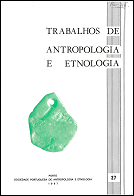Caries and pathologies at the mesolithic sites of Muge: Cabeço da Arruda and Moita do Sebastião
Resumo
deriving from the two Portuguese Mesolithic sites at Muge: Cabeço da Arruda and Moita do Sebastião" Data for these sites are compared to incidence of oral disease in other European Mesolithic The teeth from Cabeço da Arruda and Moita do Sebastião show high rates of caries with respect to a comparative sample
of other European Mesolithic specimens. Most of these differences are statistically significant, whether based on the total number of teeth or the total number of individuais in the samples. In contrast to these rates of caries involvement, the frequency of alveolar abscesses and teeth lost before death do not differ significantly frorn other Mesolithic specimens. Since experimental and epidemiological studies show that caries is primarily related to dietary items involving sugars and carbohydrates, it is postulated the diet of the prehistoric inhabitants of Muge was high in these cariogenic foods.



